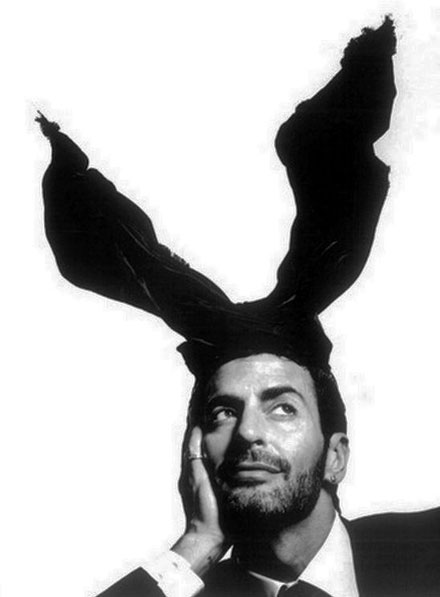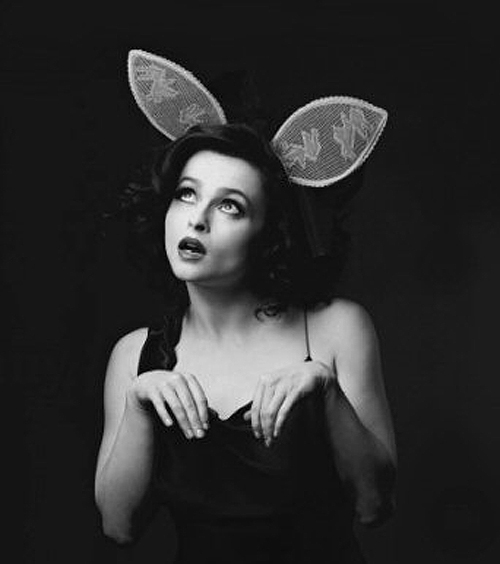“I love fairy tales because I think that behind fairy tales, there is always a meaning.”
Monica Bellucci

 Italian actress and model Monica Bellucci posing as Little Red Riding Hood
Italian actress and model Monica Bellucci posing as Little Red Riding Hood

 Red Hot Riding Hood (Tex Avery, 1943). Animated cartoon short subject
Red Hot Riding Hood (Tex Avery, 1943). Animated cartoon short subject
“The magic of Tex Avery’s animation is the sheer extremity of it all. The classic Avery image is of someone’s mouth falling open down to their feet, wham, their eyes whooping out and their tongue unrolling for about half a mile: that is the most wonderfully liberating spectacle. Avery would just stretch the human body and face however he liked, and the result was unbelievably funny. There is no hesitation in his work, no sense that you can go too far. I think that nowadays they should put on Tex Avery festivals as an antidote to political correctness. There is also a childlike sense of immortality and indestructibility in his work; people get squashed, mashed, bashed, bent out of shape, whatever, and they bounce back. In essence, it is like the myth of eternal life.”
Terry Gilliam
The 10 best animated films of all time
The Guardian, Friday 27 April 2001

 The Brothers Grimm (Terry Gilliam, 2005)
The Brothers Grimm (Terry Gilliam, 2005)

 The Brotherhood of the Wolf/ Le Pacte des Loups (Christophe Gans, 2001)
The Brotherhood of the Wolf/ Le Pacte des Loups (Christophe Gans, 2001)
French director Christophe Gans drew inspiration from manga, comics, and video games as well from filmmakers like Luchino Visconti or John Woo. “I know there is no link between them, but the truth is that the movie is very eclectic and I like to blend cinematographic genres”, he stated.
Fotogramas Magazine, issue number 1896
October 2001
 Little Red Riding Hood Meets the Wolf in the Woods by Walter Crane
Little Red Riding Hood Meets the Wolf in the Woods by Walter Crane
 “The better to see you with”, woodcut by Walter Crane
“The better to see you with”, woodcut by Walter Crane
 Illustration by Arthur Rackham
Illustration by Arthur Rackham
 Karen Elson, Red Cape and Gun. Photo by Tim Walker, 2008
Karen Elson, Red Cape and Gun. Photo by Tim Walker, 2008
 Dakota Fanning
Dakota Fanning
 Little Red Riding Hood. Lanvin ad illustrated by Remy Hetreaul, 1945
Little Red Riding Hood. Lanvin ad illustrated by Remy Hetreaul, 1945
 Woodcut by Gustave Doré
Woodcut by Gustave Doré
The origins of the Little Red Riding Hood story can be traced to versions from various European countries and more than likely preceding the 17th century, of which several exist, some significantly different from the currently known, Grimms-inspired version. It was told by French peasants in the 10th century. In Italy, the Little Red Riding Hood was told by peasants in 14th century, where a number of versions exist, including La finta nonna (The False Grandmother). It has also been called The Story of Grandmother. It is also possible that this early tale has roots in very similar Oriental tales (e.g. Grandaunt Tiger).
The theme of the ravening wolf and of the creature released unharmed from its belly is also reflected in the Russian tale Peter and the Wolf, and the other Brothers Grimm tale The Wolf and the Seven Young Kids, but its general theme of restoration is at least as old as the biblical passage Jonah and the Whale. The theme also appears in the story of the life of Saint Margaret, where the saint emerges unharmed from the belly of a dragon, and in the epic The Red Path by Jim C. Hines.
The earliest known printed version was known as Le Petit Chaperon Rouge and may have had its origins in 17th century French folklore. It was included in the collection Tales and Stories of the Past with Morals. Tales of Mother Goose (Histoires et contes du temps passé, avec des moralités. Contes de ma mère l’Oye), in 1697, by Charles Perrault. As the title implies, this version is both more sinister and more overtly moralized than the later ones. The redness of the hood, which has been given symbolic significance in many interpretations of the tale, was a detail introduced by Perrault.
The story as Rotkäppchen was included in the first edition of their collection Kinder- und Hausmärchen (Children’s and Household Tales (1812)). The earlier parts of the tale agree so closely with Perrault’s variant that it is almost certainly the source of the tale. However, they modified the ending; this version had the little girl and her grandmother saved by a huntsman who was after the wolf’s skin; this ending is identical to that in the tale The Wolf and the Seven Young Kids, which appears to be the source.



























 Elsa Peretti in a Halston-designed Bunny costume, photographed by Helmut Newton in New York City, 1975
Elsa Peretti in a Halston-designed Bunny costume, photographed by Helmut Newton in New York City, 1975 
 Playboy-inspired logo bathing suit
Playboy-inspired logo bathing suit





























